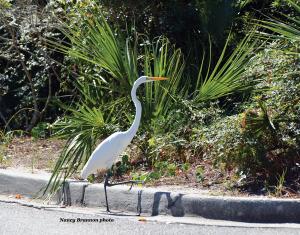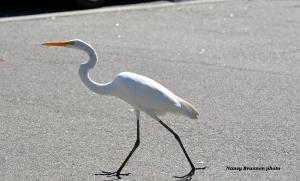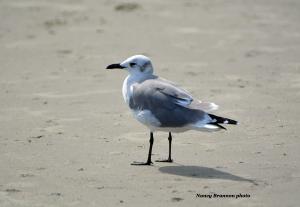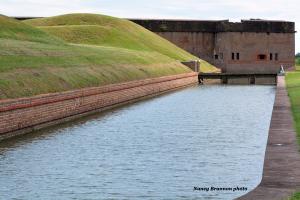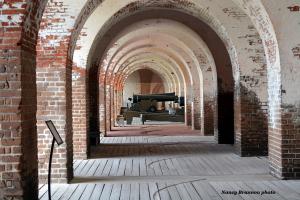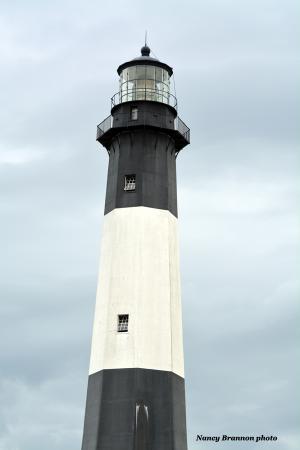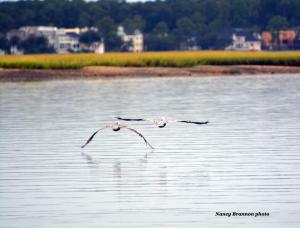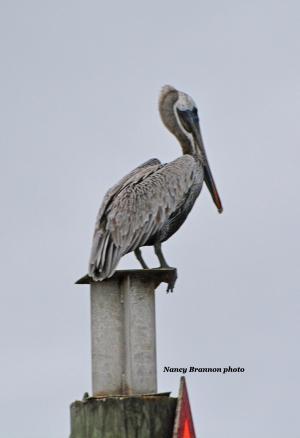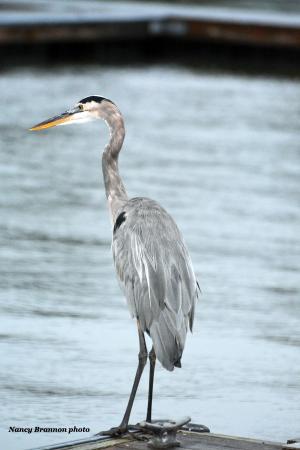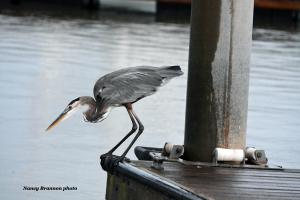Article & photos by Nancy Brannon
October turned out to be a good time for a family beach vacation to South Carolina’s Sea Islands and “Low County.” South Carolina’s Sea Islands are part of a chain of tidal and barrier islands on the Atlantic Ocean coast of the southeastern U.S., located along the coasts of South Carolina, Georgia, and Florida.
Truncated History
The Sea Islands were inhabited by indigenous cultures from around 8000 BC to 1500 AD. The Yemassee, a confederation of Native Americans, lived in the coastal region of present-day Georgia near the Savannah River in the 1500-1600s.
In the 1500s-1600s Spanish explorers began colonizing some of the islands and establishing missions. The Hernando de Soto expedition of 1540 traveled into Yemasee territory, including the village of Altamaha (located in the Piedmont region of Georgia). Additional European settlers came to the area from France (French Huguenots), England and Ireland through the 1700s.
The Plantation Era began in the early 1700s and by 1860 there were more than 20 working plantations on the island of Hilton Head, also known as Port Royal. But because of the island’s isolation and prevalence of diseases like yellow fever and malaria, most plantation owners did not live on their plantations. They resided in homes in Charleston, Beaufort, or Savannah. The island was populated primarily with slaves and overseers.
In December 1860, South Carolina was the first state to secede from the Union and on April 12, 1861 the Civil War’s first shots were fired on Fort Sumter in Charleston Harbor. Hilton Head Island was a base of operations for the Union blockade of southern ports during the Civil War. With Union control of the island, hundreds of ex-slaves fled to Hilton Head, which is still home to descendants of the Gullah people.
From the 1890s through the 1950s wealthy northerners purchased land on Hilton Head Island for private game and hunting preserves. They visited the island in the winter season to hunt turkey, quail, doves, ducks, deer, wild boar, and alligators. Horses were the main source of transportation both on the hunts and around the island, as there were no paved roads. From the 1940s to 1960s hunters brought their hunting dogs for the season. Access to the island was only by boat.
Development of Hilton Head into a resort began in 1956 with Charles E. Fraser developing the Sea Pines Resort. Fraser was a committed environmentalist who wanted to preserve as much of the native habitat as possible along with resort development.
Equines
Native to South Carolina are small horses, perhaps descendants of the survivors of shipwrecks, called Carolina Marsh Tacky Horses. Why were they called Marsh Tacky? Marsh, because wild herds lived near the salt marshes of South Carolina. “Tacky” meant inexpensive and common. A Tacky was a common term for an inexpensive horse.
Standing 13 to 15 hands, they come in various colors: bay, black chestnut, dun, or grullo. They are gentle with wide-set eyes and short, strong backs. Throughout the history of South Carolina, Marsh Tacky horses have been rounded up, tamed, and used to ride, as pack horses or to pull carts, wagons or plows. Marsh Tackies used to be the most common horses in South Carolina, but now, only as few as 275 are left. The Coastal Discovery Museum on Hilton Head Islans has two Marsh Tackies who are sometimes on exhibit to visitors.
Gullah Culture
For more than 300 years, the Gullah people, descendants of slaves, have lived in the South Carolina Low Country, particularly on Daufuskie and Saint Helena Sea Islands. After the Civil War and into the 20th century, the Gullah community lived in relative isolation on islands with no bridges and little contact with the mainland. Fishing, oystering, and farming were their way of life. Much of the Low Country’s cuisine originated with the Gullah – okra gumbo, shrimp and gravy cooked with spices, and rice purlo. The Gullah creole dialect is a mixture of English and African languages. One of the best known Gullah expressions, “Kumbaya,” translated “come by here,” is the key element of a famous folksong. Gullah sweetgrass baskets, treasured for their beauty and artistry, are woven by hand as they were in the 18th century.
Historic Mitchelville, located on Hilton Head Island’s Port Royal Sound, was the first self-governed town of freed slaves in America. Since 2003, the Gullah Museum of Hilton Head Island preserves the history of Gullah customs, traditions, language, stories, songs and structures on the island.
Ecosystem and Natural Habitat
Hilton Head Island is the second largest barrier island on the Eastern Seaboard. The north end is a sea island dating to the Pleistocene epoch and the south end is a barrier island that appeared in the Holocene epoch. The terrain spans from a beach system with offshore sand bars, grassy dunes behind the beach, maritime forests with wetlands in the interiors, to salt or tidal marshes.
The island is home to a vast array of wildlife, including alligators, deer, loggerhead sea turtles, manatees, dolphins, and hundreds of species of birds.
Protecting Loggerhead Sea Turtles, especially during their nesting season, is an important project of the South Carolina Department of Natural Resources from May through October, known as the Sea Turtle Protection Project.
The waters around Hilton Head Island are one of the few places on Earth where dolphins routinely use a technique called “strand feeding,” whereby schools of fish are herded up onto mud banks, and the dolphins lie on their side while they feed before sliding back down into the water.
On the mainland, Live Oak Trees with Spanish Moss, along with Palmettos, are a common, signature sight around the island.
Salt March Ecology
The salt marsh estuaries are the feeding grounds, breeding grounds, and nurseries for many saltwater species of game fish, sport fish, and marine mammals. The dense plankton population gives the coastal water its murky brown-green coloration. Plankton support marine life including oysters, shrimp and other invertebrates, and bait-fish species including menhaden and mullet, which in turn support larger fish and mammal species that populate the local waterways.
South Carolina’s coastal ecosystem is heavily influenced by its tidal range. The coast’s marshland habitats are intertidal, meaning that the tide ebbs and flows twice a day within these habitats.
Live oyster reefs are found in the middle and low intertidal zones. They provide nursery and forage habitat to many marine species including blue crab, stone crab, shrimp, flounder, speckled trout, redfish, and striped bass. Oysters also improve the coastal water quality, sifting algae from the water column, indirectly filtering the water of excess nutrients. In fact, a single oyster can filter roughly fifty gallons of water per day!
Marsh habitats are dominated by grasses in both salty and brackish portions of the coastal ecosystem. The dominant plant species found in tidal salt marsh is smooth cordgrass (Spartina alterniflora), but brackish and salt marshes are home to a variety of plant species such as glasswort, salt marsh aster, black needle rush, and sea oxeye. Coastal marshes provide critical ecosystem services like shoreline stabilization; wave attenuation; provision of nursery and foraging habitat for ecologically important species of plants and animals; water quality enhancement; carbon sequestration; and much more.
The marsh grass Spartina has some interesting characteristics. It is the only grass with adaptations needed to survive in the low salt marsh environment. Glands along its blades excrete excess salt. A root-rhizome system acts as an anchor, holding the grass steady against high wave energy; as salinity decreases it shares space with other species; the stems and root mats of Spartina are highly effective at accumulating fine sediment, thus helping control sea level rise.
Salt marshes rank among the most productive ecosystems on earth. In late fall, the green Spartina begins to turn brown as leaves die and decomposition begins. Water, waves, wind and storms dislodge and break up decaying leaves, and transport them to mud flats and other locations around the marsh. This dead plant matter (detritus) forms an attachment site for microscopic organisms such as bacteria, fungi and small algae. These organisms colonize the broken bits of plant material and break down portions of the detritus that are not digestible by animals.
Fiddler crabs and marsh snails shred dead plant material during feeding, aiding the decomposition process. Oysters and mussels filter these particles from the water. When low tide exposes the marsh, these animals either burrow into the mud or close up into their shells. The young of many species such as blue crabs, white shrimp, and red drum utilize the salt marsh as a nursery. Some of these aquatic organisms stay within the creeks throughout the tidal cycle, but many others move on and off the marsh surface with the tide. Once they leave the protection of the marsh surface to enter the adjacent tidal creeks, they become more susceptible to large predators. One of the few reptiles that lives in the salt marsh, the diamond back terrapin, forages during high tide but moves to high ground to lay their eggs above the high tide mark. Alligators pass through brackish marshes, but usually avoid high salinity marshes.
Many species of birds feed on the abundance of small fishes and invertebrates that live in the salt marsh. Herons, egrets, and ibises feed on fishes, shrimp, and fiddler crabs. Terns and ospreys dive on fish easily visible in the shallow water, while sandpipers and their relatives probe exposed mud flats for small snails and marine worms. Only two birds nest in South Carolina's salt marshes: Clapper rails, often heard but seldom seen, hunt for fiddler crabs among the stalks of Spartina and black needle rush, where they build their nests above the reach of the tides. Marsh Wren, prolific singers during the spring breeding season, weave tall Spartina stems into nests along the creek banks. Bottlenose dolphins sometimes leave the deeper water of the bays and sounds to find prey in the smaller creeks.
There are plenty more things to do and see in the Low Country, such as going on a Dolphin Watch cruise, visiting lighthouses, and touring Fort Pulaski at Savannah. One of the most fascinating things you’ll see at Fort Pulaski is the striped mullet periodically leaping out of the water in the moat that surrounds the fort. Unfortunately, my camera and I were not fast enough to capture these amazing jumping fish.
Whenever you go on vacation, be sure to check out the local ecosystem, flora and fauna. It will abundantly enhance your experience.
Sources:
Purcell, Andrew D., Pushkar Khanal, Thomas Straka, and Evan D. Cook. 2019. “South Carolina’s Coastal Habitats and Regional Comparison. Dec. 10. Land Grant Press by Clemson Extension. https://lgpress.clemson.edu/publication/south-carolinas-coastal-habitats-and-regional-comparison/
Coastal Discovery Museum, Natalie Hefter, Editor. 1998. Images of America: Hilton Head Island. Arcadia Publishing.
Salt Marsh Guide. https://www.saltmarshguide.org/guide/ecological-setting/
South Carolina Department of Natural Resources. “Dynamics of the Salt Marsh.” https://www.dnr.sc.gov/marine/pub/seascience/dynamic.html
S.C. Sea Grant Consortium. Coastal Ecosystems and Natural History. https://www.scseagrant.org/coastal-ecosystems-and-natural-history/
Carolina Wetlands Association. State of the Wetlands. http://carolinawetlands.org/index.php/state-of-the-wetlands/
Natural History Journal. 2019. “South Carolina’s Salt Marshes and Tidal Creeks.”
https://natural-history-journal.blogspot.com/2019/08/exploring-new-places-south-carolinas_21.html
Hilton Head Island. “Discovering the Low Country Maritime Forest.” https://www.hiltonheadisland.com/discovering-the-lowcountry-maritime-forest/
Carolina Marsh Tacky Horses:
https://www.design42.com/hiltonhead/2018/04/04/carolina-marsh-tacky-horses/
https://discoversouthcarolina.com/articles/meet-the-marsh-tacky-south-carolinas-lowcountry-horse
https://www.viator.com/tours/Hilton-Head-Island/Marsh-Tacky-Horse-Tour-at-Coastal-Discovery-Museum/d31480-69951P4
October turned out to be a good time for a family beach vacation to South Carolina’s Sea Islands and “Low County.” South Carolina’s Sea Islands are part of a chain of tidal and barrier islands on the Atlantic Ocean coast of the southeastern U.S., located along the coasts of South Carolina, Georgia, and Florida.
Truncated History
The Sea Islands were inhabited by indigenous cultures from around 8000 BC to 1500 AD. The Yemassee, a confederation of Native Americans, lived in the coastal region of present-day Georgia near the Savannah River in the 1500-1600s.
In the 1500s-1600s Spanish explorers began colonizing some of the islands and establishing missions. The Hernando de Soto expedition of 1540 traveled into Yemasee territory, including the village of Altamaha (located in the Piedmont region of Georgia). Additional European settlers came to the area from France (French Huguenots), England and Ireland through the 1700s.
The Plantation Era began in the early 1700s and by 1860 there were more than 20 working plantations on the island of Hilton Head, also known as Port Royal. But because of the island’s isolation and prevalence of diseases like yellow fever and malaria, most plantation owners did not live on their plantations. They resided in homes in Charleston, Beaufort, or Savannah. The island was populated primarily with slaves and overseers.
In December 1860, South Carolina was the first state to secede from the Union and on April 12, 1861 the Civil War’s first shots were fired on Fort Sumter in Charleston Harbor. Hilton Head Island was a base of operations for the Union blockade of southern ports during the Civil War. With Union control of the island, hundreds of ex-slaves fled to Hilton Head, which is still home to descendants of the Gullah people.
From the 1890s through the 1950s wealthy northerners purchased land on Hilton Head Island for private game and hunting preserves. They visited the island in the winter season to hunt turkey, quail, doves, ducks, deer, wild boar, and alligators. Horses were the main source of transportation both on the hunts and around the island, as there were no paved roads. From the 1940s to 1960s hunters brought their hunting dogs for the season. Access to the island was only by boat.
Development of Hilton Head into a resort began in 1956 with Charles E. Fraser developing the Sea Pines Resort. Fraser was a committed environmentalist who wanted to preserve as much of the native habitat as possible along with resort development.
Equines
Native to South Carolina are small horses, perhaps descendants of the survivors of shipwrecks, called Carolina Marsh Tacky Horses. Why were they called Marsh Tacky? Marsh, because wild herds lived near the salt marshes of South Carolina. “Tacky” meant inexpensive and common. A Tacky was a common term for an inexpensive horse.
Standing 13 to 15 hands, they come in various colors: bay, black chestnut, dun, or grullo. They are gentle with wide-set eyes and short, strong backs. Throughout the history of South Carolina, Marsh Tacky horses have been rounded up, tamed, and used to ride, as pack horses or to pull carts, wagons or plows. Marsh Tackies used to be the most common horses in South Carolina, but now, only as few as 275 are left. The Coastal Discovery Museum on Hilton Head Islans has two Marsh Tackies who are sometimes on exhibit to visitors.
Gullah Culture
For more than 300 years, the Gullah people, descendants of slaves, have lived in the South Carolina Low Country, particularly on Daufuskie and Saint Helena Sea Islands. After the Civil War and into the 20th century, the Gullah community lived in relative isolation on islands with no bridges and little contact with the mainland. Fishing, oystering, and farming were their way of life. Much of the Low Country’s cuisine originated with the Gullah – okra gumbo, shrimp and gravy cooked with spices, and rice purlo. The Gullah creole dialect is a mixture of English and African languages. One of the best known Gullah expressions, “Kumbaya,” translated “come by here,” is the key element of a famous folksong. Gullah sweetgrass baskets, treasured for their beauty and artistry, are woven by hand as they were in the 18th century.
Historic Mitchelville, located on Hilton Head Island’s Port Royal Sound, was the first self-governed town of freed slaves in America. Since 2003, the Gullah Museum of Hilton Head Island preserves the history of Gullah customs, traditions, language, stories, songs and structures on the island.
Ecosystem and Natural Habitat
Hilton Head Island is the second largest barrier island on the Eastern Seaboard. The north end is a sea island dating to the Pleistocene epoch and the south end is a barrier island that appeared in the Holocene epoch. The terrain spans from a beach system with offshore sand bars, grassy dunes behind the beach, maritime forests with wetlands in the interiors, to salt or tidal marshes.
The island is home to a vast array of wildlife, including alligators, deer, loggerhead sea turtles, manatees, dolphins, and hundreds of species of birds.
Protecting Loggerhead Sea Turtles, especially during their nesting season, is an important project of the South Carolina Department of Natural Resources from May through October, known as the Sea Turtle Protection Project.
The waters around Hilton Head Island are one of the few places on Earth where dolphins routinely use a technique called “strand feeding,” whereby schools of fish are herded up onto mud banks, and the dolphins lie on their side while they feed before sliding back down into the water.
On the mainland, Live Oak Trees with Spanish Moss, along with Palmettos, are a common, signature sight around the island.
Salt March Ecology
The salt marsh estuaries are the feeding grounds, breeding grounds, and nurseries for many saltwater species of game fish, sport fish, and marine mammals. The dense plankton population gives the coastal water its murky brown-green coloration. Plankton support marine life including oysters, shrimp and other invertebrates, and bait-fish species including menhaden and mullet, which in turn support larger fish and mammal species that populate the local waterways.
South Carolina’s coastal ecosystem is heavily influenced by its tidal range. The coast’s marshland habitats are intertidal, meaning that the tide ebbs and flows twice a day within these habitats.
Live oyster reefs are found in the middle and low intertidal zones. They provide nursery and forage habitat to many marine species including blue crab, stone crab, shrimp, flounder, speckled trout, redfish, and striped bass. Oysters also improve the coastal water quality, sifting algae from the water column, indirectly filtering the water of excess nutrients. In fact, a single oyster can filter roughly fifty gallons of water per day!
Marsh habitats are dominated by grasses in both salty and brackish portions of the coastal ecosystem. The dominant plant species found in tidal salt marsh is smooth cordgrass (Spartina alterniflora), but brackish and salt marshes are home to a variety of plant species such as glasswort, salt marsh aster, black needle rush, and sea oxeye. Coastal marshes provide critical ecosystem services like shoreline stabilization; wave attenuation; provision of nursery and foraging habitat for ecologically important species of plants and animals; water quality enhancement; carbon sequestration; and much more.
The marsh grass Spartina has some interesting characteristics. It is the only grass with adaptations needed to survive in the low salt marsh environment. Glands along its blades excrete excess salt. A root-rhizome system acts as an anchor, holding the grass steady against high wave energy; as salinity decreases it shares space with other species; the stems and root mats of Spartina are highly effective at accumulating fine sediment, thus helping control sea level rise.
Salt marshes rank among the most productive ecosystems on earth. In late fall, the green Spartina begins to turn brown as leaves die and decomposition begins. Water, waves, wind and storms dislodge and break up decaying leaves, and transport them to mud flats and other locations around the marsh. This dead plant matter (detritus) forms an attachment site for microscopic organisms such as bacteria, fungi and small algae. These organisms colonize the broken bits of plant material and break down portions of the detritus that are not digestible by animals.
Fiddler crabs and marsh snails shred dead plant material during feeding, aiding the decomposition process. Oysters and mussels filter these particles from the water. When low tide exposes the marsh, these animals either burrow into the mud or close up into their shells. The young of many species such as blue crabs, white shrimp, and red drum utilize the salt marsh as a nursery. Some of these aquatic organisms stay within the creeks throughout the tidal cycle, but many others move on and off the marsh surface with the tide. Once they leave the protection of the marsh surface to enter the adjacent tidal creeks, they become more susceptible to large predators. One of the few reptiles that lives in the salt marsh, the diamond back terrapin, forages during high tide but moves to high ground to lay their eggs above the high tide mark. Alligators pass through brackish marshes, but usually avoid high salinity marshes.
Many species of birds feed on the abundance of small fishes and invertebrates that live in the salt marsh. Herons, egrets, and ibises feed on fishes, shrimp, and fiddler crabs. Terns and ospreys dive on fish easily visible in the shallow water, while sandpipers and their relatives probe exposed mud flats for small snails and marine worms. Only two birds nest in South Carolina's salt marshes: Clapper rails, often heard but seldom seen, hunt for fiddler crabs among the stalks of Spartina and black needle rush, where they build their nests above the reach of the tides. Marsh Wren, prolific singers during the spring breeding season, weave tall Spartina stems into nests along the creek banks. Bottlenose dolphins sometimes leave the deeper water of the bays and sounds to find prey in the smaller creeks.
There are plenty more things to do and see in the Low Country, such as going on a Dolphin Watch cruise, visiting lighthouses, and touring Fort Pulaski at Savannah. One of the most fascinating things you’ll see at Fort Pulaski is the striped mullet periodically leaping out of the water in the moat that surrounds the fort. Unfortunately, my camera and I were not fast enough to capture these amazing jumping fish.
Whenever you go on vacation, be sure to check out the local ecosystem, flora and fauna. It will abundantly enhance your experience.
Sources:
Purcell, Andrew D., Pushkar Khanal, Thomas Straka, and Evan D. Cook. 2019. “South Carolina’s Coastal Habitats and Regional Comparison. Dec. 10. Land Grant Press by Clemson Extension. https://lgpress.clemson.edu/publication/south-carolinas-coastal-habitats-and-regional-comparison/
Coastal Discovery Museum, Natalie Hefter, Editor. 1998. Images of America: Hilton Head Island. Arcadia Publishing.
Salt Marsh Guide. https://www.saltmarshguide.org/guide/ecological-setting/
South Carolina Department of Natural Resources. “Dynamics of the Salt Marsh.” https://www.dnr.sc.gov/marine/pub/seascience/dynamic.html
S.C. Sea Grant Consortium. Coastal Ecosystems and Natural History. https://www.scseagrant.org/coastal-ecosystems-and-natural-history/
Carolina Wetlands Association. State of the Wetlands. http://carolinawetlands.org/index.php/state-of-the-wetlands/
Natural History Journal. 2019. “South Carolina’s Salt Marshes and Tidal Creeks.”
https://natural-history-journal.blogspot.com/2019/08/exploring-new-places-south-carolinas_21.html
Hilton Head Island. “Discovering the Low Country Maritime Forest.” https://www.hiltonheadisland.com/discovering-the-lowcountry-maritime-forest/
Carolina Marsh Tacky Horses:
https://www.design42.com/hiltonhead/2018/04/04/carolina-marsh-tacky-horses/
https://discoversouthcarolina.com/articles/meet-the-marsh-tacky-south-carolinas-lowcountry-horse
https://www.viator.com/tours/Hilton-Head-Island/Marsh-Tacky-Horse-Tour-at-Coastal-Discovery-Museum/d31480-69951P4
